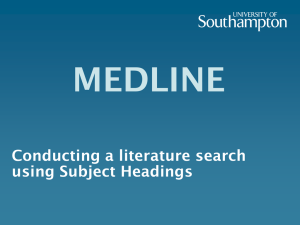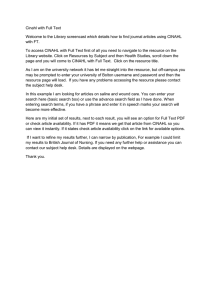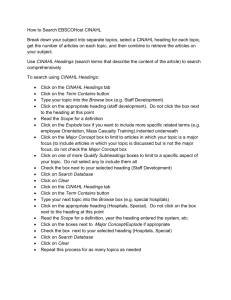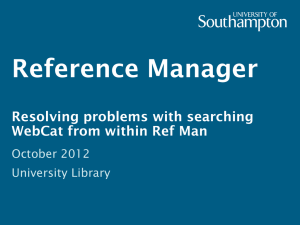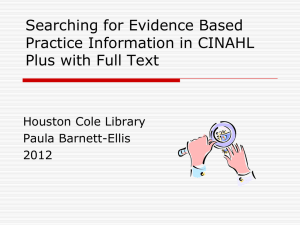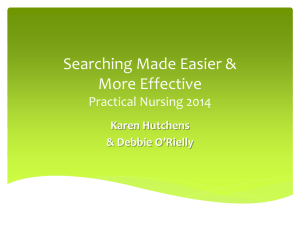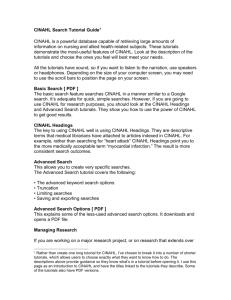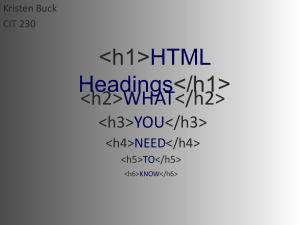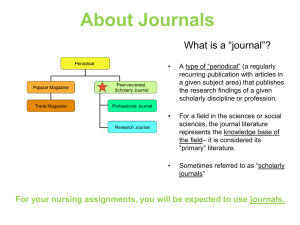CINAHL subject heading search
advertisement
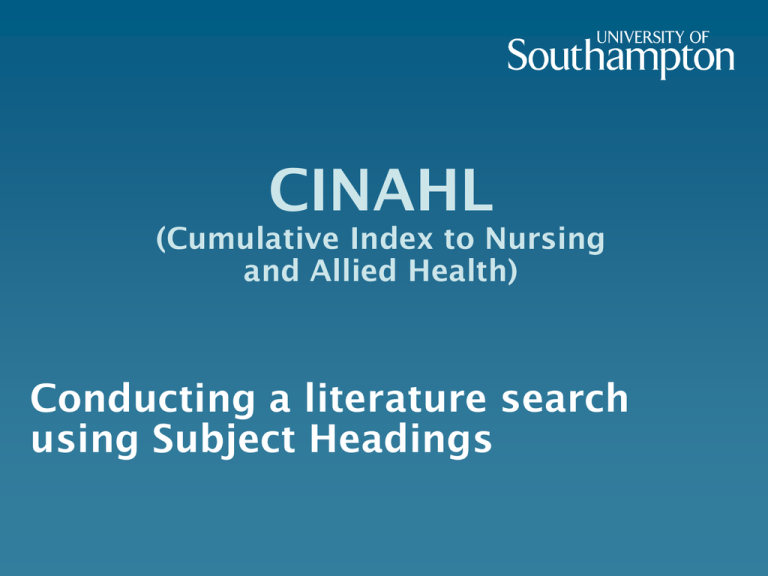
CINAHL (Cumulative Index to Nursing and Allied Health) Conducting a literature search using Subject Headings This presentation will help you to: Section 1 Create a search strategy Section 2 Using the database CINAHL search for journal article references Section 3 Check to see if we have articles available via the library Why use Subject Headings rather than Keyword searching? - 1 CINAHL Subject Headings are assigned to each record to describe the subject content of the record. They are applied consistently which means that once you have identified the correct CINAHL Heading(s) you do not need to think about synonyms, different word endings or alternative spellings. For example, an article on stroke will have the subject heading stroke assigned to it even if the author of the article uses a synonym such as cva, cvas, cerebrovascular accident or cerebral vascular accident . And……. Why use Subject Heading rather than Keyword searching? - 2 The indexers also assign the subject terms according to the level of importance of the term within the article; the most important points called are called Major Subjects and those of lesser importance called Minor Subjects For instance….. We can see this when we look at a reference in CINAHL Why use Subject Heading rather than Keyword searching? - 3 You tend to retrieve articles that are more relevant: Searching using the subject heading stroke will retrieve articles that are about the medical condition stroke whereas free text searching will retrieve any article which has the word in the title or abstract, whether that is relevant to the subject of the article or not. They could also include references to articles about pet therapy (people who stroke animals are more relaxed) and references about swimming or heat stroke. But…. …..subject headings are not infallible so to make sure you retrieve all relevant articles a combination of subject headings and free text is sometimes required. CINAHL (Cumulative Index to Nursing and Allied Health Literature) Comprehensive database covering Nursing, Midwifery and Allied Health subjects Lists articles in over 900 English language journals Over 3 million records Data since 1982 Available via the Library Web pages using your iSolutions username and password Bibliographic databases what do they do? List the “bibliographic” details of journal articles – author and title of the article; journal title, volume, issue and pages. Mostly refer to journal articles, but some refer to newspapers, conference papers, book chapters or videos. They can be searched – much like WebCat. But they are nationally or internationally produced so….. …we do not have access to the full-text of all of the journal references on CINAHL Section 1 Putting together your search strategy Search example: “What research evidence is there to support the theory that exercise or exercise programmes help in the prevention of falls in the elderly?” But before you start searching you need to spend some time thinking about your search….. You need to: Identify the concepts of your query List alternative phrases and keywords Include both narrow and broad terms Identify any key periods of research Identify any key authors in the field Question, Concepts & Keywords “What research evidence is there to support the theory that exercise or exercise programmes help in the prevention of falls in the elderly?” Identify your search terms “What research evidence is there to support the theory that exercise or exercise programmes help in the prevention of falls in the elderly?” The key topics are obvious “What research evidence is there to support the theory that exercise or exercise programmes help to prevent falls in the elderly?” falls elderly exercise prevention But how else can these topics be described and do we need to include them all? Join these terms together using: Boolean logic and Truncation Boolean Logic…. Allows you to search for multiple keywords or combines different expressions for the same concept teenagers or adolescents and links two different concepts together children and communication Truncation Finds any keyword with a common stem Truncation symbol is commonly Physiotherap* will find: physiotherapist physiotherapists physiotherapy * Section 2 Starting your search Library home page www.soton.ac.uk/library Select the relevant subject link Then choose the Databases and Indexes link Link to CINAHL Links to guides 1. Place tick here 2. Enter term and then search 1. You are taken to a list of suggested subject terms Placing a tick here tags the heading and also opens up some more options…. Subheadings Subheadings allow a search to be restricted to one or more facets, such as diagnosis, therapy, or psychosocial aspects thereby providing more specific references. 2. Explode or major concept? 1. We will also add some other useful headings Exploding Exploding retrieves any articles that include the controlled term that you search for plus all articles featuring narrower (more specific) terms which are hidden underneath the subject term. Major Concept When you select Major Concept for a term, you create a search query that finds only records for which the subject heading is a major focus of the article. Standard Subject Heading search option This search option will return results where your term is considered to be either a Minor or Major subject term so…… ….if you want your search results to contain your subject where it is both a major and minor subject term then use…. …..this ‘search database link’ 2. Tick box 3. Enter next term then search 1. Results of first search 2. Search Takes you to the suggested subject term Aged 1. Tick other relevant boxes Tick box, enter final search term and search If you are thinking of exploding your term then looking at the structure behind the term helps to see how the database works . To do this…….. 1. Tick box next to exercise 2. Open up the term exercise by clicking on the link We will explode the term to include all of the more specific options but terms can also be marked individually if you do not require all of them 1. Combine searches 1, 2 and 3 together using AND 1. Results of final search 2. To cut your search results down use the the Revise Search options link to open up Final result. To look at the references use this link or scroll down See full details of the reference by using this title link If you just want to look at the abstract hold mouse over magnifying glass 3. Return to results link at the top of the page 2. Subject terms added to this reference 1. Abstract Either of these two links will take you to the full text of the article Use these icons to print, save or email article Details of the reference If there is no full text link select the TDNet icon This screen shows that the article is available. Use this link to open it up. It is always better to use the PDF option But…. 58 …you may find that we don’t have access to the article If we don’t have access to a reference which is really important then use our Inter-Library Loans service: Login to WebCat Go to: Requests: inter-library loans and stack Inter-library loan requests Choose the relevant form for the item you are requesting, complete the form then submit Please check to see the number of inter-library loan requests your are entitled to at www.southampton.ac.uk/library/services/ill.html Saving the details of the references and your search history 2. Then go to the folder view at the top of the page 1. Add to folder those references you want to save, page by page….. 1. Select references (again) 2. Choose your method of output Warning! Don’t send your results to a work address outside of the University, i.e. an NHS email account as the firewall set up by other organisations may block any attachments. Summing up When you have a piece of academic work to do: First of all decide what information do you want, is it going to be in books, journal articles, a Department of Health publication or a practice guideline from your professional organisation? • • • Books – use WebCat Journal articles – use CINAHL DoH publications/professional guidelines – use their web sites or NHS Evidence Then work out your search strategy What are the key topics? Mindmap/list them. What are other ways of describing them? Use Boolean operators and truncation to make a simple search strategy. Then finally start using the databases Use the most relevant to search for information. Use the limits to narrow down your search. Use the TDNet link to see if we have the full text of the articles. Read the articles and reference them in your assignment. Do well and celebrate! Copying and Copyright You should assume that everything is subject to copyright law, unless this is clearly stated otherwise You should save, print or email only one copy of an article from an issue of a magazine or journal. In the case of a book, pamphlet or report, you should make single copies of not more than one chapter, or extracts amounting to no more than 5% of the entire work For more information see: www.soton.ac.uk/library/about/regulations/ copyrightphotocopying. html Citing References When literature searching: Record full details of reference Record how and when you found it When writing up: Link each reference to the correct place in the text Reference all sources that you use (and do not reference sources that you don’t use!) Follow the FoHS referencing guidelines Be consistent Applying for interlibrary loans How many inter-library loans may I have? Faculty of Health Sciences Staff 15 Postgraduate Research students 15 Postgraduate Taught students 10 Undergraduate students 3 (For each academic year) Choose the relevant form for the item you are requesting Complete form and then place request For further details of this service go to: www.southampton.ac.uk/library/services/ill.html Cochrane database Go back to the Health Sciences library Databases and Indexes page But be careful if you decide to print, this full article is actually 163 pages long……… ….instead start by looking at the plain language summary which you will find by scrolling down the page Subject gateways and web sites 1. Go back to the Health Sciences library subject page 2. Open websites link Getting Help Subject Enquiries Level 3, Hartley Library Or contact libenqs@soton.ac.uk
